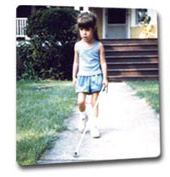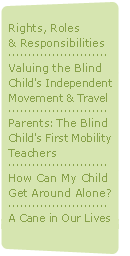|
 A
Cane in Our Lives A
Cane in Our Lives
by
Carol Castellano
Reprinted from Future Reflections
Last
Christmas, when she was five years old, our daughter
Serena received a cane from Santa Claus. To be sure,
her father and I were a lot more excited about it than
she was that first day, but it wasn't long before Serena
discovered just what it would mean to have a cane in
her life.
She
realized immediately that by holding that long object
out in front of her, she could avoid bumping into things
with her nose. She also found that she could get advance
warning of steps, curbs, changes in the terrain, and
the like. She no longer had to rely on holding someone's
hand to avoid potential danger. Suddenly she was free!
It
took her about a week and a half to incorporate the
new tool into her existing repertoire of travel skills—and
then there was no stopping her. The sidewalk was hers.
Unfamiliar stairways—no problem. The way to our
neighbors' house was easily learned and Serena strolled
over to deliver a package. At the mall she was free
to explore corridors and enjoy the echoes. Finding elevator
doors was a snap; escalators provided great amusement
(for her, not me). We were able to begin teaching her
how to cross our quiet street alone, a skill appropriate
to her age. We began to walk to the park like other
families, holding hands sometimes for the pure pleasure
of it and not because we had to.

One
day my husband and I walked over with the children to
the local school to vote. While we were busy signing
in, Serena went off exploring. She followed the strains
of an orchestra which was rehearsing in the school auditorium,
a few hallways away. Halfway down the aisle, heading
for the stage, was the new Miss Independence. What possibilities
the cane opened up! I recall how it used to strike me
as a little odd to see in the Braille Monitor
picture after picture of people posing with their canes.
Were they showing pride in being blind, I wondered?
Were they trying to prove a point? Eventually I came
to understand that the white cane is both a symbol of
independence for blind people and a basic tool of making
independence a reality. Matter-of-factly showing the
cane in a photograph expresses the fundamental normalcy
of blind people's lives.
 In
a Halloween picture of my children, the Angel Serena
stands holding her cane next to brother Devil. It's
not a display; it's not a soapbox issue. To us, a cane
in Serena's hand is just the most natural thing. When
our NFB friends gathered for a picnic in our backyard,
Serena at one point was hanging around in the kitchen
comparing canes with the rest of the gang. Just the
most natural thing. In
a Halloween picture of my children, the Angel Serena
stands holding her cane next to brother Devil. It's
not a display; it's not a soapbox issue. To us, a cane
in Serena's hand is just the most natural thing. When
our NFB friends gathered for a picnic in our backyard,
Serena at one point was hanging around in the kitchen
comparing canes with the rest of the gang. Just the
most natural thing.
When
I look back, I realize that getting the cane was the
most significant event to happen to our family this
year. It vastly changed Serena's level of independence;
it changed mine. At Grandma's house, we can simply direct
her to the steps; no longer do I have to hang onto her
along with anything else I might be carrying; she can
proceed independently at her own pace. At the library
I can rush ahead with my pile of books, without worrying
about her tripping on the steps or falling into the
fountain. When we arrive at friends' houses, she can
navigate the front walks and stairways herself. Serena
goes from our car in the driveway, along the walk, up
the front steps, and into the house alone; I do not
have to walk her. Since we are in and out of the car
so many times each day, this skill was very important
to my freedom.

The
cane greatly raised our expectations. It is natural
now for Serena to move along independently. We expect
this of her; more importantly, she expects it of herself.
Would Serena have progressed as much if she hadn't had
a cane? I think not. Her curiosity and urge to explore
would have been thwarted; she would not have been able
to move about nearly as freely beyond the four walls
of our home. Her development would have been needlessly
hampered.
It
is hard to believe that canes are not given as a matter
of course to young blind children, since the cane is
probably the most important external factor in the development
of independence. What does it say about the attitudes
of many professionals towards blind people and independence
if they will not give canes to children? Could it mean
that it is satisfactory, in their eyes, for the blind
always to be followers, always to be led?
It
is impossible to understand—and chilling to ponder—why
anyone would argue against normal, natural independence
in a child's life. That is what the cane makes possible.
It provides the opportunity for the blind child to make
the normal developmental moves away from his or her
parents, to be just like any other child, expected and
encouraged to venture with increasing independence into
the world.
One
day a few weeks ago, Serena's cane got stuck in a crack,
and when she pulled it out it broke. The magnitude of
the disaster suddenly struck her.
"Ooooh,"
she whined, "now we're going to have to hold hands."
With
thanks to Joe Cutter, 0 & M instructor, a creative and
innovative person who teaches parents to teach their
children and who believes in and respects other people,
sighted and blind.

|


 A
Cane in Our Lives
A
Cane in Our Lives In
a Halloween picture of my children, the Angel Serena
stands holding her cane next to brother Devil. It's
not a display; it's not a soapbox issue. To us, a cane
in Serena's hand is just the most natural thing. When
our NFB friends gathered for a picnic in our backyard,
Serena at one point was hanging around in the kitchen
comparing canes with the rest of the gang. Just the
most natural thing.
In
a Halloween picture of my children, the Angel Serena
stands holding her cane next to brother Devil. It's
not a display; it's not a soapbox issue. To us, a cane
in Serena's hand is just the most natural thing. When
our NFB friends gathered for a picnic in our backyard,
Serena at one point was hanging around in the kitchen
comparing canes with the rest of the gang. Just the
most natural thing.